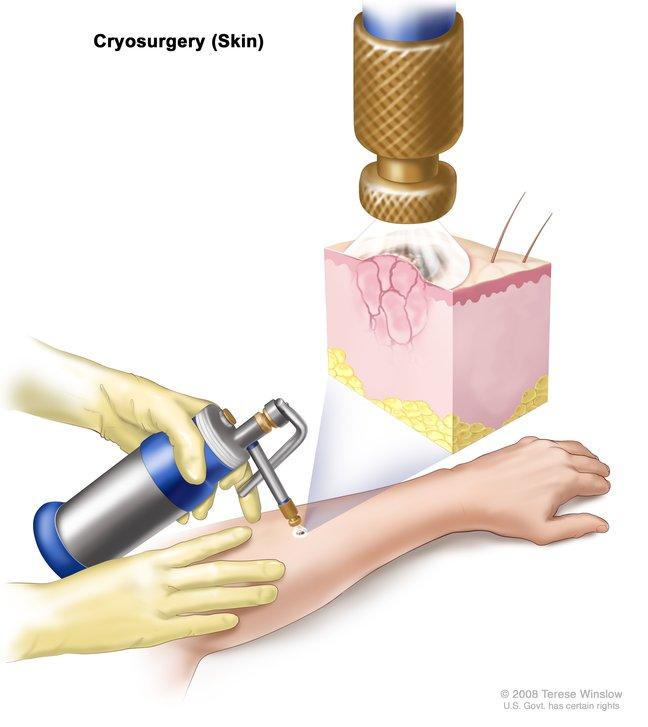Cryosurgery to Treat Cancer
What is cryosurgery?
Cryosurgery is a treatment that uses extreme cold produced by liquid nitrogen or argon gas to destroy cancer cells and abnormal tissue. It is a local treatment, which means that it is directed toward a specific part of your body. Cryosurgery is used to treat tumors on the skin, as well as certain tumors inside the body.
Cryosurgery may also be called cryotherapy or cryoablation.
Cancers treated with cryosurgery
Cryosurgery can be used to treat the following types of cancer:
- retinoblastoma
- skin cancers, including basal cell and squamous cell carcinomas
- skin lesions from AIDS-related Kaposi sarcoma
- early-stage prostate cancer
- liver cancer that is confined to the liver
- bone cancer, mostly chondrosarcoma
- non-small cell lung cancer
Cryosurgery is also used to treat the following conditions that are not cancer:
- skin growths called actinic keratoses that can turn into cancer
- abnormal cell changes in the cervix that can turn into cervical cancer, known as cervical intraepithelial neoplasia or cervical precancer
- benign bone tumors, such as enchondroma, giant cell tumor, aneurysmal bone cyst, and chondroblastoma
How cryosurgery treats cancer
Cryosurgery freezes tissue, causing cells in the treated area to die.
For tumors on the skin, the doctor applies liquid nitrogen directly to the abnormal area with a cotton swab or spraying device. For tumors inside the body, the doctor may use a device called a cryoprobe to freeze the tumor tissue. Cryoprobes may be put into the body during surgery or through a small cut in the skin. As liquid nitrogen or argon gas flows through the cryoprobe, the doctor places it directly on the tumor. During this procedure, the doctor uses ultrasound or MRI to guide the cryoprobe to the correct spot, which helps limit damage to nearby healthy tissue. Sometimes, more than one cryoprobe is used to freeze different parts of the tumor.
When the frozen tissue thaws, the cells die. Tumors that were frozen inside the body will be absorbed. Tumors that were frozen on the skin will form a scab that will fall off as the damaged skin heals.
Cryosurgery may be used with other cancer treatments such as hormone therapy, chemotherapy, immunotherapy, radiation therapy, or surgery. For example, the tissue remaining after a primary bone tumor has been removed by surgery may be treated with cryotherapy to help reduce the risk that the tumor will come back.
Benefits of cryosurgery
Cryosurgery has many benefits.
- For tumors inside the body, only a small cut or puncture is usually needed to insert the cryoprobe through the skin. As a result, pain, bleeding, and other problems that come with surgery are reduced.
- Cryosurgery can often be done with local anesthesia and may not require a hospital stay.
- Since cryosurgery is a local treatment and doctors can focus treatment on a precise area, damage to nearby healthy tissue can be reduced.
- Cryosurgery can be repeated safely and may be used with other cancer treatments.
- Cryosurgery may be used when tumors can’t be removed with surgery or when people can’t have surgery because of their age or other medical problems.
- Cryosurgery may be an option when the cancer does not respond to standard treatments.
Drawbacks of cryosurgery
For some uses of cryosurgery, doctors do not know how well it controls cancer or improves how long people live over the long term. Also, cryosurgery can only be used to treat tumors that can be seen by using imaging tests.
Because the long-term value of cryosurgery for some cancers and precancers is still being tested, its use may not be covered by insurance.
Side effects from cryosurgery
Cryosurgery can cause side effects, although they are likely to be less severe than those from other local treatments, such as surgery or radiation therapy. The side effects that you might have depend mostly on the part of your body that is treated. For instance:
- Cryosurgery to treat abnormal cervical cells can cause cramping, pain, or bleeding.
- Cryosurgery for skin tumors may cause scarring and swelling. If nerves are damaged, you may have a loss of feeling. Rarely, it may cause a loss of skin pigment or hair in the treated area.
- Cryosurgery to treat tumors in bone may lead to the damage of nearby bone tissue that in time will cause broken bones.
- Cryosurgery to treat tumors in the liver may cause damage to the bile ducts and major blood vessels, which can lead to heavy bleeding or infection.
- Cryosurgery to treat prostate cancer can cause urine flow to be blocked, incontinence, impotence, and damage to the rectum. You are more likely to have side effects from cryosurgery if you have also had radiation therapy to the prostate.
Where to go for cryosurgery
For simple procedures, you will have cryosurgery in a doctor’s office as an outpatient. For more complex ones, you may need to stay in the hospital.
A small number of hospitals and cancer centers throughout the country have skilled doctors and machines needed to perform more complex procedures. Talk with your doctor or contact hospitals and cancer centers in your area to find out if they are using cryosurgery.
Cryosurgery research
Researchers are studying cryosurgery as a possible treatment for:
- oral cancer and conditions of the mouth that can turn into cancer
- breast cancer
- colon cancer
- pancreatic cancer
- kidney cancer
They are also studying the use of cryotherapy with other cancer treatments, such as hormone therapy, chemotherapy, immunotherapy, radiation therapy, and surgery.
If you are interested in finding a clinical trial that uses cryosurgery, use the advanced search form or contact NCI’s Cancer Information Service.


